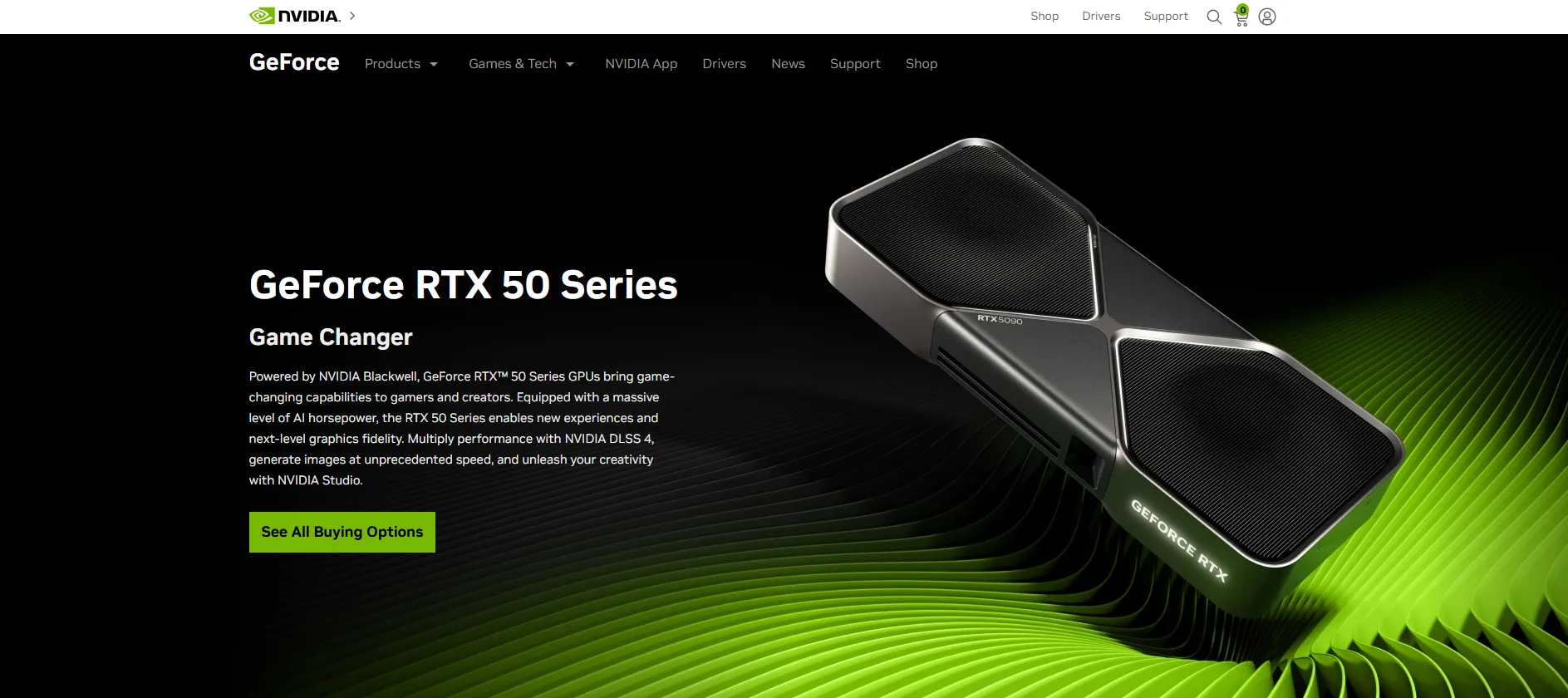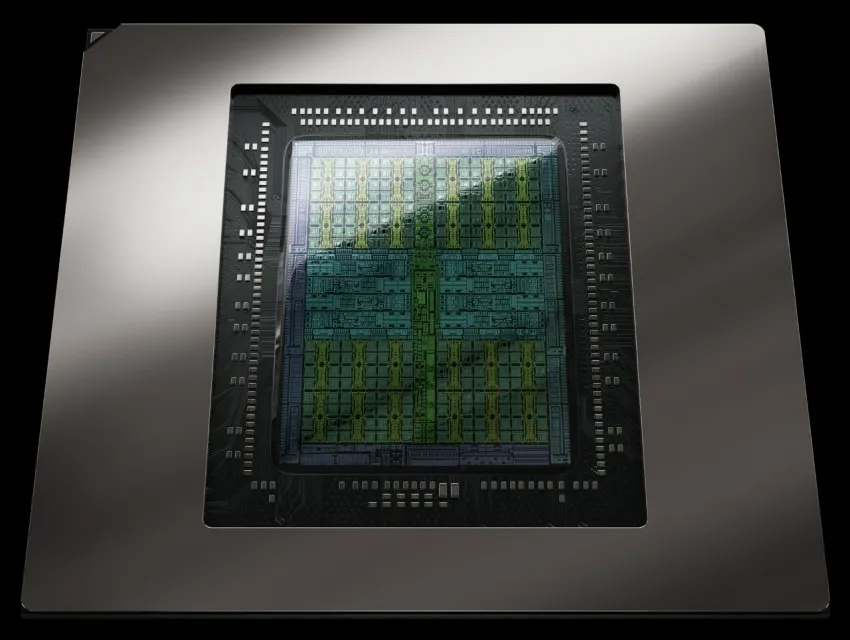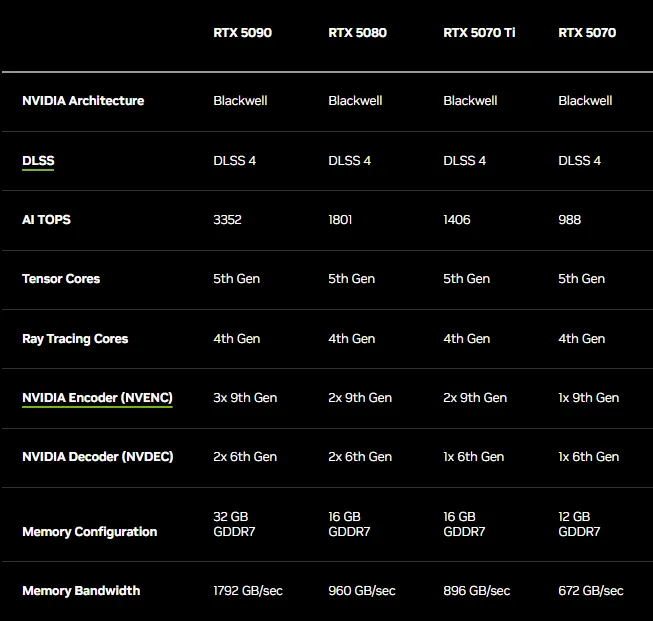Introduction
The GeForce 50 series is a series of consumer graphics processing units (GPUs) developed by Nvidia as part of its GeForce line of graphics cards, succeeding the GeForce 40 series. Announced at CES 2025, it debuted with the release of the RTX 5080 and RTX 5090 on January 30, 2025. It is based on Nvidia’s Blackwell architecture featuring Nvidia RTX’s fourth-generation RT cores for hardware-accelerated real-time ray tracing, and fifth-generation deep-learning-focused Tensor Cores. The GPUs are manufactured by TSMC on an improved custom 4NP process node.

RTX 50-Series: Expected Specifications
1.New Blackwell GPU Architecture
The GeForce 50 series is powered by the Blackwell microarchitecture which continues Ada Lovelace’s emphasis on high graphics frequencies and large L2 caches. The Blackwell architecture introduces Nvidia RTX’s fourth-generation RT cores for hardware-accelerated real-time ray tracing and fifth-generation Tensor Cores for AI compute and performing floating-point calculations.

Fifth-Gen Tensor Cores
Max AI performance with FP4 and DLSS 4
New Streaming Multiprocessors
Optimized for neural shaders
Fourth-Gen Ray Tracing Cores
Built for Mega Geometry
2.Enhanced Ray Tracing and DLSS 4.0
Nvidia’s ray tracing technology is set to improve significantly, providing more realistic lighting, shadows, and reflections in games.DLSS 4.0 (Deep Learning Super Sampling) will leverage advanced AI algorithms to provide even better upscaling, image quality, and performance boosts.
DLSS is a revolutionary suite of neural rendering technologies that uses AI to boost FPS, reduce latency, and improve image quality. The latest breakthrough, DLSS 4, brings new Multi Frame Generation and enhanced Ray Reconstruction and Super Resolution, powered by GeForce RTX™ 50 Series GPUs and fifth-generation Tensor Cores. DLSS on GeForce RTX is the best way to play, backed by an NVIDIA AI supercomputer in the cloud constantly improving your PC’s gaming capabilities.
3.GDDR7 Memory for Faster Bandwidth
Nvidia is likely to introduce GDDR7 memory with the RTX 50-Series, significantly increasing memory bandwidth.This means faster data transfer rates, reducing bottlenecks and enhancing overall performance in high-resolution gaming and AI workloads. RTX 50 series GPUs are the first consumer GPUs to feature GDDR7 video memory for greater memory bandwidth over the same bus width compared to the GDDR6 and GDDR6X memory used in the GeForce 40 series. RTX 50 series desktop GPUs use GDDR7 modules from Samsung due to them being available for validation earlier than modules from SK Hynix and Micron.
4. Energy Efficiency & Cooling Improvements
A major focus on power efficiency, reducing heat output while maximizing performance. Advanced cooling solutions, including vapor chamber cooling and improved fan designs.
RTX 50-Series: Gaming and AI Performance Expectations
Gaming Performance:
✅ 4K Ultra Gaming at Higher Frame Rates: Expect smooth 4K gaming at 144Hz+, even in demanding AAA titles. ✅ Better Ray Tracing Performance: More immersive lighting and reflections with minimal FPS loss. ✅ DLSS 4.0 AI Upscaling: Improved AI-powered frame generation, making lower resolutions look near-native.
AI & Content Creation:
✅ Faster AI Model Training: Perfect for machine learning, data science, and AI-based applications. ✅ Enhanced Video Editing & Rendering: Professionals using tools like Blender, Premiere Pro, and DaVinci Resolve will see improved rendering times. ✅ AI-Powered Workflows: AI-driven optimizations will assist in automation, improving productivity across various industries.
RTX 50-Series: Specs

Expected Pricing of the Nvidia RTX 50-Series GPUs
While official pricing details remain unknown, we can estimate based on previous generations:
- Nvidia GeForce RTX 5090: $1,599 – $1,799
- Nvidia GeForce RTX 5080: $999 – $1,199
- Nvidia GeForce RTX 5070: $699 – $899
- Nvidia GeForce RTX 5060: $399 – $599
These prices may vary depending on market conditions, competition from AMD Radeon and Intel Arc, and Nvidia’s pricing strategy.
Conclusion
The Nvidia RTX 50-Series GPUs are shaping up to be a major leap forward in graphics technology. With improvements in performance, efficiency, AI capabilities, and ray tracing, these GPUs will redefine gaming, AI processing, and creative workloads.If you’re a tech enthusiast, gamer, or professional user, keeping an eye on the RTX 50-Series launch is a must. Stay tuned for more updates as Nvidia reveals official details!
Frequently Asked Questions (FAQs)
Will there be a 50 series GPU?
GeForce RTX 50 Series. Powered by NVIDIA Blackwell, GeForce RTX™ 50 Series GPUs bring game-changing capabilities to gamers and creators. Equipped with a massive level of AI horsepower, the RTX 50 Series enables new experiences and next-level graphics fidelity.
What is the highest RTX GPU?
The Nvidia GeForce RTX 5090 is now the most powerful graphics card on the market, even if it claims that title with a bit less force than in previous generations. The most powerful consumer GPU out there, period.
Is RTX 50 better than 40?
As expected, the RTX 5090, with its healthy dollop of extra TSMC 4N CUDA cores is the winner out of all the new cards. You’re looking at a straight ~30% performance uplift over the RTX 4090 when you take Frame Gen out of the equation, and a doubling of performance when you do.










